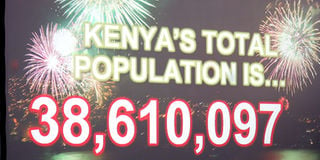Breaking News: At least 10 feared to have drowned in Makueni river
Kenya growing at a million people a year

A giant screen displays the latest population on Kenya which stands at 38.6 million nationally, up from 28 million in 1999. PHOTO / CORRESPONDENT
What you need to know:
- That means we need more of everything - schools, hospitals, jobs and housing - urgently
The average Kenyan woman is having 4.6 babies, pushing up the country’s population by a million people every year.
As a result, the population now stands at 38.6 million nationally, up from 28 million in 1999, raising alarm among experts and government officials who say more resources will now be required to take care of the bulging population.
But it is the growth in population of the Somali community, now Kenya’s sixth largest community, that is most noticeable in the results of the 2009 census figure released by Planning Minister Wycliffe Oparanya on Tuesday.
At nearly 2.4 million people, Kenyan Somalis are now classified as more than the Kisii (2.2 million) and the Mijikenda (nearly two million).
North Eastern Province has grown from 371,391 in 1989 to the present 2.3 million people.
Figures in five districts in the province were disputed and nullified, same as those in three districts in Turkana. In explaining the nullification, Mr Oparanya said the rate of increase was higher than the population dynamics (birth and death rates).
“Age and sex profiles deviate from the norm. Significant growth is observed in household size without accompanying growth in number of households,” he said.
The increase in the number of people in North Eastern has, however, always been rapid. Between 1969 and 1979, for example, the area’s population grew by 52 per cent, from 245,757 to 373,787.
It is between 1989 and 1999, coinciding with the collapse of the Republic of Somalia, that the most rapid growth was observed, at 159 per cent to 962,142.
Between 1999 and 2009, the province had a population growth rate of 140 per cent, four times the national average.
Slightly more than half of 38.6 million Kenyans live in Rift Valley, Nyanza and Western regions, according to the national census.
Rift Valley, the most populous province, has 10 million, Nyanza 5.4 million and Western 4.3 million people.
Mr Oparanya warned that the government and experts must come up with more strategies to reverse the growth.
“This high rate of population growth has adverse effects on spending in infrastructure, health, education, environment, water and other social and economic sectors,” warned Mr Oparanya.
It was also significant that the major communities in the three regions—the Luhya, Kalenjin and Luo—took the second, third and fourth positions nationally in terms of population.
The Luhya, who are 5.33 million are the second most populous community, after the Kikuyu (6.62 million), while the Kalenjin are the third most with 4.96 million and the Luos fourth with 4.04 million. The Kisii were seventh with 2.20 million.
The Kamba were ranked fifth nationally with 3.89 million people.
According to the results, the number of Muslims stands at 4.3 million while those of Hindus stands at 53,393.
Protestants topped the list with 18.3 million members followed by catholics (9 million). Other christians comprise 4.5 million, pagans (922,128), traditionalist (635,352), other religions (557,450), don’t know (61,233).
The country’s population is projected to reach 51.3 million in 2025, if the current population growth is maintained, which will make Kenya one of the most populous countries in Africa.
Achieve Vision 2030 goals
Mr Oparanya said in order for the government to achieve the Vision 2030 goals, there was need to invest more in education to meet to demands of the growing school age population and the demand for future manpower.
“Critical investment will be required in family planning services, health and other social and economic sectors to improve the welfare of Kenyans,” he added, referring to the high fertility rate, currently standing at 4.6 births per woman.
The country has almost an equal number of males and females, with the former being 19,192,458 and the latter 19,417,639, meaning that the government will have to implement policies that ensure fair distribution of services among the sexes.
Districts that had their results nullified because of inconsistent figures are Lagdera, Wajir East, Mandera Central, Mandera East, Mandera West, Turkana Central, Turkana North and Turkana South.
Though fertility rates have slightly declined from 4.9 in 2003 to the current 4.6, Kenya is still experiencing a ‘youth bulge’ with the bigger chunk of the population, 24.5 million, aged below 25 years.
According to Mr Kwame Owino, of the Institute of Economic Affairs, the numbers of the youth show that education and employment will be critical as Kenya struggles to transform itself into a middle-income country.
“The country will need more schools, teachers and health facilities, all this will need more funding,” said Mr Owino.
He said the national government and the county governments will also have to think of a taxation policy, adding that though there is a large labour force, the bigger part of the population is dependent on a small percentage in gainful employment.
On household assets, the radio is the most popular and is owned by 74 percent of households, followed by mobile phones owned by 63.2 percent of households and televisions (28 percent).
This will be the last census where provinces are considered as administrative units. They have been abolished under the new constitution and replaced with 47 counties.
On counties, Nairobi tops the list of the most densely populated category with 3.1 million people, hosting 1.6 million males and 1.5 million females, a pointer to migration of men from rural areas.




